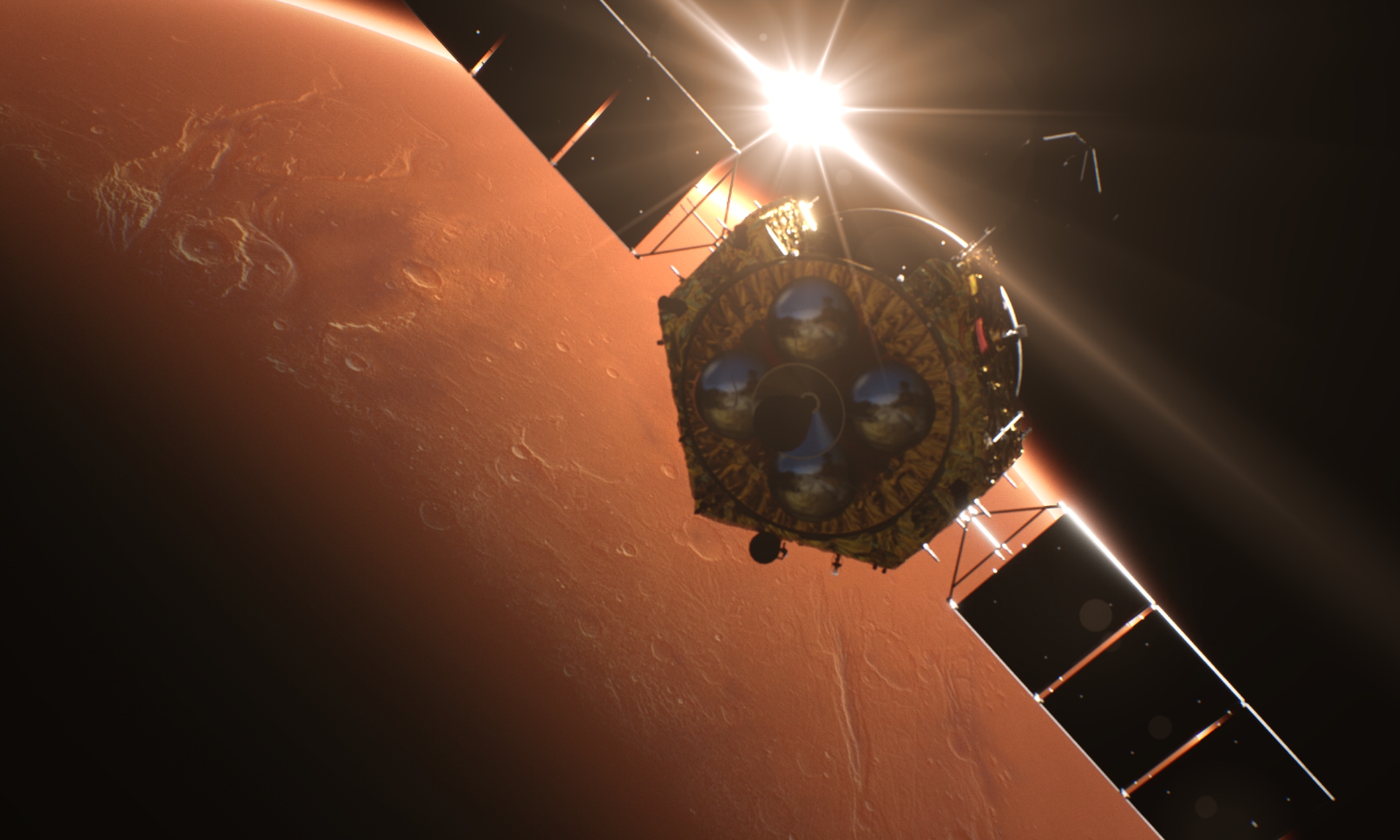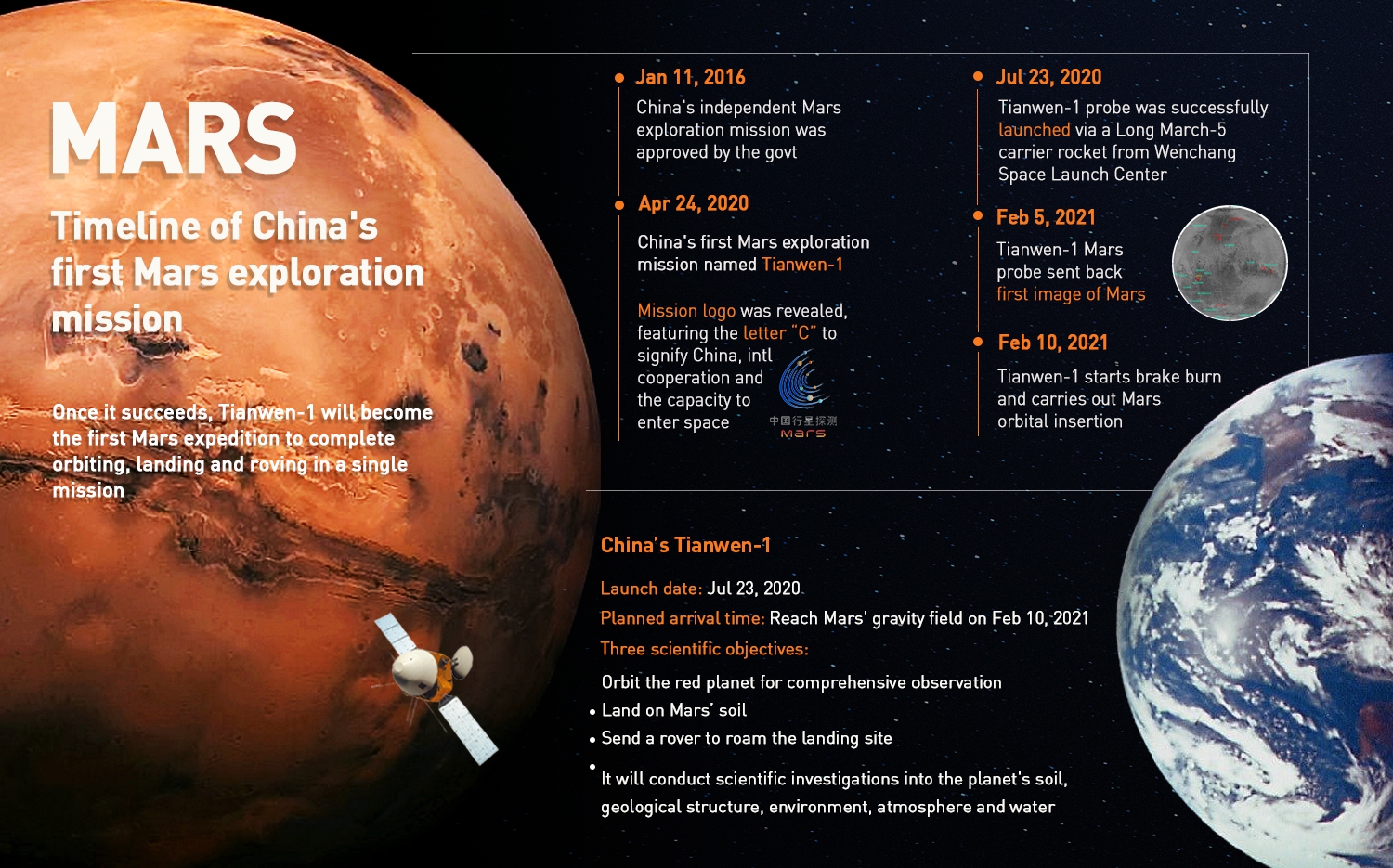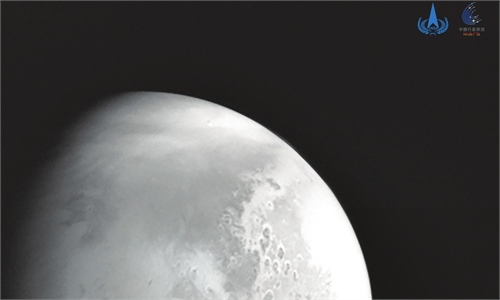SCI-TECH / AIR & SPACE
China’s Tianwen-1 probe successfully enters Mars orbit

Illustrations of the Tianwen-1 Mars orbital insertion Photo: courtesy of CASC
Tianwen-1, China's first Mars probe, successfully reached the Red Planet on Wednesday at around 7:52 pm, homing in on the Earth's planetary neighbor after an epic seven-month journey of nearly 500 million kilometers.
After a 15-minute firing of its 3,000-newton thrust engine, the spacecraft reached an elliptical Mars orbit at around 400 kilometers from the planet, according to a statement China's National Space Administration (CNSA) provided to the Global Times on Wednesday.
Tianwen-1 circuitous flight has seen the spacecraft travel some 475 million kilometers, taking it some 192 million kilometers from Earth, with all systems in good condition, CNSA said. The communication time delay between the probe and Earth is about 10.7 minutes.
It will carry out several orbital course corrections before finally selecting a landing spot and touching down, which is scheduled to happen between May and June.
Having nailed the highly complex Mars orbital insertion maneuver, China has become the sixth entity to have sent a spacecraft into orbit around Mars, following the Soviet Union, the US, the European Space Agency, India and the UAE. It is the third country to accomplish such a feat on its first attempt after India and the UAE.
Twenty-four hours ahead of China's Tianwen-1, the UAE's first Mars mission, Hope, entered orbit around the planet late Tuesday night, on a mission to study the planet's atmosphere and weather. NASA's rover landing is expected to take place on February 18.
Weighing over 5 tons with the height and diameter reaching four meters, Tianwen-1 is undoubtedly the largest and heaviest of the three Mars buddies.
The distance between the moon and Earth is about 360,000 to 400,000 kilometers, while the distance between Mars and Earth is 56 million to 400 million kilometers. The longest distance between Earth and Mars is 1,000 times that between Earth and moon.
The long distance equates to a considerably delay in communication, which could be as long as 10 minutes, according to Pang Zhihao, a former researcher at the China Academy of Space Technology and space science author.
The success of Tianwen-1's Mars orbit insertion which is a highly demanding task for China's space tracking and monitoring system due to lengthy communication delays caused by the Earth-Mars distance, fully verified the system's capability and reliability, Song Zhongping, a space expert and TV commentator, told the Global Times on Wednesday.
Chinese netizens, thrilled by the latest development of Tianwen-1's mission, flocked to leave congratulatory comments on Sina Weibo, expressing great pride in China's aerospace development and high hopes for future missions.
After braking into Mars gravity, Tianwen-1 will begin orbiting the planet, during which it will examine the landforms and conduct a surface survey of Mars, especially the feasibility of its preset landing spot, Wang Ya'nan, chief editor of Beijing-based Aerospace Knowledge magazine, told the Global Times on Wednesday.
"If the landform of the preset landing area returns unfeasible results, the spacecraft needs to adjust or decide on a new place to touch down, which means that orbiting will last longer to ensure its safe landing," Wang said.
The decision on the landing area will also take into consideration the power supply for the rover, which relies on solar power to remain in operation. If the rover lands in the northern hemisphere, it is likely that it will receive insufficient sunlight and stop working; therefore, the ideal place for touchdown is around the equator of Mars, CCTV News reported.
"Possible landing sites include the largest plain on the Red Planet known as the Utopia Planitia. If all goes smoothly, the spacecraft will arrive on the Mars surface in May," the report said.
Wang added that the touchdown on Mars will be more difficult than that on the moon since there is no atmosphere to disturb the landing maneuver on the moon, but the environment on the Red Planet is much more complicated, creating more interference as the probe lands. However, the previous success of Chang'e-5 has accumulated rich experiences in this regard which "boosts our confidence," Wang noted.

Infographic: GT
The most challenging maneuver, which scientists dub the "breathtaking seven minutes," will deploy multiple cutting-edge technologies and the accurate timing of each action, including the burning of engines and opening of parachutes, which will slow the craft down and ensure a safe landing.
Due to the great distance between Mars and the Earth which causes a significant communication delay, scientists at Earth's command center won't receive a signal or deal with any problems that may occur during touchdown for the first seven minutes, which means that the probe must be "smart" enough to solve all potential problems on its own.
China launched the Mars probe on July 23, 2020, which is designed to complete orbiting, landing and roving in one single mission. After orbiting Mars for about three months, China's Tianwen-1 will deploy a lander and rover bundled together to land at Utopia Planitia around May.
China's ambitious plan to carry out Mars "orbiting, landing and roving" all in one go has no precedence in human history, and if successful, will no doubt mark a huge advancement on its way to becoming a world space power, Song hailed.
Song expect Tianwen-1 to lay a significant and solid foundation for China's future Mars missions which will include collecting a Mars sample and returning to earth, and even a crewed mission to Mars.
The Global Times learned from China's space authority that Tianwen-1 is expected to achieve a slew of scientific goals including study of the morphology and geology of the planet and Mars' atmosphere ionized layer, surface climate and environment.


